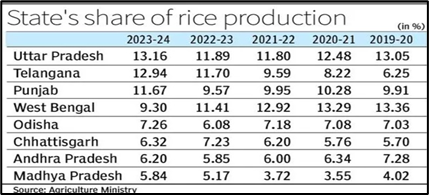Why in news?
Recently, the Indian government lifted the ban on the export of Non-Basmati White Rice. However, it set a minimum export price (MEP) of $490 per tonne.
Earlier, the government had removed the 20% export duty on Non-Basmati White Rice and reduced the export duty on three other rice categories: 'rice in the husk (paddy or rough)', 'husked (brown) rice', and 'parboiled rice' from 20% to 10%.
What’s in today’s article?
- Rice Cultivation
- Rice Production in India
- India’s status as a rice exporter
- Export ban on Non-Basmati White Rice lifted
Rice Cultivation
- Crop Season
- Rice is primarily grown during the Kharif season (June to November), which coincides with the monsoon.
- In some areas, it is also grown in the Rabi season (November to April), particularly in irrigated regions like Tamil Nadu and coastal Andhra Pradesh.
- Climatic Conditions
- Rice thrives in tropical and subtropical regions with high humidity. It requires:
- Temperature: An average temperature of 21°C to 37°C. The ideal temperature for germination is around 21°C, while the growing period requires temperatures above 25°C.
- Rainfall: Rice needs plenty of water. It requires 150-300 cm of rainfall during the growing period, ideally distributed evenly throughout the season.
- Soil Conditions
- Rice grows best in clayey or loamy soils that retain water.
- Alluvial soils in river basins and coastal areas are also ideal for rice cultivation. The soil should be deep, fertile, and capable of holding moisture.
- Water Requirements
- Rice is a water-intensive crop, usually grown in flooded fields (paddy fields). Adequate irrigation is necessary in areas with insufficient rainfall.
Rice Production in India
- Area of cultivation for rice
- In fiscal year 2024, India had an estimated 47.6 million hectares of land area for rice cultivation.
- India is the second-largest producer of rice globally, and the largest exporter.
- Production
- India's rice production in 2023-24 is estimated to be 1378.25 lakh metric tons (LMT), a 20.70 LMT increase from the previous year.
- State's share in rice production

- Rice is produced in the coastal strips on the eastern and western pockets of the country, the plains of Assam in the north-east, and the foothills of the Himalayas.
India’s status as a rice exporter
- Statistics
- India is the second-largest rice producer and the largest exporter globally, contributing significantly to world rice trade.
- Along with China, India accounts for over half of the world's rice production. While China is the largest consumer, leaving little for export, India plays a dominant role in the export market.
- According to the USDA, India accounted for 33% (17 million tonnes) of the world’s total rice exports (53 million tonnes) in 2023.
- In 2022, before the Non-Basmati White Rice export ban, India contributed about 40% of the global rice exports (56 million tonnes).
- India’s export breakup
- India’s rice exports are divided into two main categories: basmati and non-basmati rice.
- Basmati rice accounts for nearly one-third of India’s total rice exports, with 52.42 lakh tonnes exported in 2023-24.
- Non-basmati rice has six subcategories: rice in husk (seed quality and other), husked (brown) rice, parboiled rice, non-basmati white rice, and broken rice.
- Export destination
- The primary destinations for Indian rice exports in 2023-24 are Saudi Arabia, Iran, Iraq, Benin, United Arab Emirates, Guinea, Senegal, Togo, and Yemen.
- Saudi Arabia was the leading importer of Indian rice in terms of export value, mainly purchasing basmati rice varieties.
- Non-basmati white rice went to Kenya, Mozambique, Cameroon, Vietnam, Malaysia, Togo, Madagascar, Cote D’ Ivoire, and Benin in the biggest quantities.
- India’s competitor
- Two east Asian countries—Thailand and Vietnam—are the two main competitors of India in the global rice market.
- In 2023, the combined rice export of these two countries was almost equal to Indian exports.
- Besides, Pakistan, Cambodia and the United States are also in the list of rice exporters.
- Philippines, Indonesia, Vietnam, China, European Union, Nigeria, Iraq, Saudi Arabia and Malaysia are the top rice importers.
Export ban on Non-Basmati White Rice lifted
- About the news
- The Centre has lifted the ban on export of Non-Basmati White Rice. It has, however, imposed a minimum export price (MEP) of $490 per tonne.
- Reasons behind lifting the ban
- Higher Sowing of Paddy
- India has seen an increase in paddy sowing due to a good monsoon, with most of the crop being planted during the kharif season.
- By September 20, 2023, the paddy cultivation area reached 413.50 lakh hectares, a 2.2% increase over last year.
- Record Rice Production
- India’s total rice production for 2023-24 (kharif, rabi, and summer) is estimated at 137.82 million tonnes, a 1.5% increase compared to last year.
- Declining Wholesale Prices, Stable Retail Inflation
- On September 27, the wholesale price of rice was Rs 3,324.99 per quintal, down from Rs 3,502.91 a month ago.
- However, retail inflation based on the Consumer Price Index has remained in double digits for the past two years, peaking at 13.09% in July 2023.
- Inflation dropped to 9.52% in August after the government’s export ban.
- Surplus Rice Stocks
- As of September 1, the Food Corporation of India (FCI) held 323.11 lakh tonnes of rice in its Central pool.
- Including unmilled paddy, the total stock amounted to 423 lakh tonnes, well above the required buffer stock norms of 135.40 lakh tonnes for July and 102.50 lakh tonnes for October.
- Who will get benefitted?
- The lifting of the ban will benefit traders, who previously paid a 20% duty, and is expected to improve export sentiment.
- Farmers growing premium varieties like Sona Masoori (mainly in Karnataka, Andhra Pradesh, and Telangana) are likely to benefit, as they were impacted by the ban.
- However, for domestic consumers, already high retail prices may increase further.










